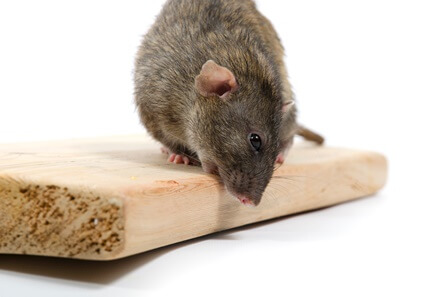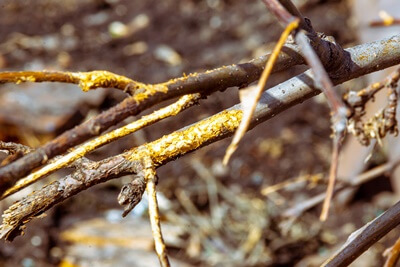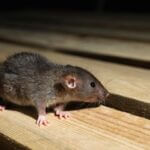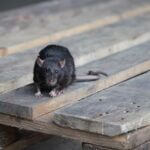Last Updated on: 4th June 2022, 09:37 am
Rats will chew through anything they can, regardless of whether it’s edible. Despite having small teeth, they have strong jaws that can deliver a strong bite force to tough and resilient materials.
Rats find gnawing through wood easier than chewing through harder materials, like metal and glass.
They’ll chew wooden furniture, floorboards, baseboards, walls, cabinets, window frames, etc. If the wood is compromised by water damage or has degraded over time, the task will be even easier.
Rats gnaw on objects to prevent their incisors from growing too long. So, rats will gnaw through any material that isn’t harder than their teeth (on the Mohs scale) to wear them down naturally.
Why Do Rats Chew Wood?
Since rats’ incisors grow throughout their lives, they need to constantly gnaw and brux (grind their incisors together) to wear them down to an optimal length.
If rats’ teeth were allowed to grow unchecked, they’d continuously grow at a tilted angle, making it impossible to close their mouths or chew. If the teeth grew unchecked, they’d cause injury.
While rats will chew any material that isn’t harder than their teeth, they prefer wooden items. That’s because wood is much easier to chew than certain metals, glass, and other hard materials.
That said, rats’ teeth are harder than some metals, including copper, platinum, and iron. According to the Mohs scale (which ranks minerals on a scale of 1 to 10, depending on their hardness level), rats’ teeth have a ranking of 5.5.
This is higher than human teeth, which are ranked at 5.0. You’ll have noticed that rats’ teeth are yellow or orange, which indicates the presence of iron. Considering how tough rats’ teeth are, it’s hardly surprising that they can easily chew through wood.
In addition to chewing furniture, rats will gnaw at any wooden structures in your home. This includes wooden floorboards, baseboards, doors, window frames, kitchen cabinets, and roofing beams.
If the wood is old or weather-damaged, this will make the task faced by rats even easier.

Identifying Rodent Bite Marks
One of the first signs of rats is bite marks on furniture and other wooden structures. Rats usually leave paired bite marks, which are approximately ⅛ inch long and 2 mm wide.
How to Tell if You Have Mice or Rats Through Bites
Bite marks provide crucial information about an animal’s teeth’ arrangement, shape, and size.
Therefore, by examining the appearance of bite marks on a wooden surface, you can determine what kind of rodent pest you have in your home. This can be coupled with other methods, such as comparing rat and mice droppings.
Both rats and mice have four incisor teeth at the front of each jaw (two on the top and two on the bottom). So, they leave similar bite marks on wood and other surfaces.
However, rats have larger teeth than mice and will leave more pronounced bite marks, at about ⅛ inch long and 2 mm wide. The bite marks of mice tend to be smaller and have a raggedy appearance.
How Long Does It Take A Rat To Chew Through Wood?
There’s no set timeframe. It can take a single rat as little as 2 hours or as long as 2 weeks to chew through a thin layer of wood. The thicker and healthier the wood, the longer it’ll take for rats to chew through it.
However, if the wood’s toughness has been ravaged by time, the task will be made easier. Also, a rat will be more determined to get through if they’re desperate to reach the other side.
Rats can chew through wood fairly easily since their teeth are strong and sharp. Moreover, they have enlarged jaw muscles that allow their jaws to move vertically, forward, and backward.
Do Rats Eat Wood?
Rats are unlikely to eat wood for nourishment.
Although wood is an entirely natural substance, it’s not flavorful and doesn’t contain anything that will sustain them. So, rats won’t want to eat wood or wooden items.
However, rats will chew through wooden items, including furniture, door frames, cabinets, and floorboards, to reach food sources.
Do Rats Like Wood Piles?
A pile of lumber can serve as a shelter for rats, keeping out the cold and rain.
Keep your woodpile away from your home, ensure it’s not resting against the floor, cover it up with some tarp, and regularly visit the area to deter rodent activity.
How Do You Stop Rats From Chewing Wood?
As highlighted, rats can cause significant damage and destruction to furniture and other wooden surfaces that are part of a home’s structure.
If left unchecked, their persistent gnawing can weaken the structure of a home and necessitate repairs that can cost hundreds or thousands of dollars to resolve.
Here are some steps you can take to protect your home and furniture from damage by rats:

Seal Any Entry Points
According to the University of Nebraska, rats can enter a home through any opening at least ½ inch wide.
As long as they can get their heads to fit through a hole, rats will squeeze the rest of their body through the tiniest of holes.
Therefore, you need to ensure all potential entry points are identified and properly sealed to prevent them from gaining access to your home.
Repair Leaking Pipes
Rats are often drawn to people’s homes by leaking pipes and high moisture areas, which provide a reliable water source. Dehydration presents a significant risk to rodents.
So, clean up any spillages and enlist a plumber to fix any leaking pipes and faucets.
Store Food in Airtight Containers
Rats enter homes in search of food and warm nesting locations. If rats can smell food using their exceptional olfactory senses, they’re more likely to appear.
So, if you tend to leave food in the open, the scent can lure rats to your home, putting your furniture and other wooden structures at risk of significant damage.
To prevent this, store food in airtight containers and seal your garbage bins.
Rats can gnaw through wood. By taking the above precautions, you can ensure a temporary infestation doesn’t lead to aesthetic or structural damage to your home.







